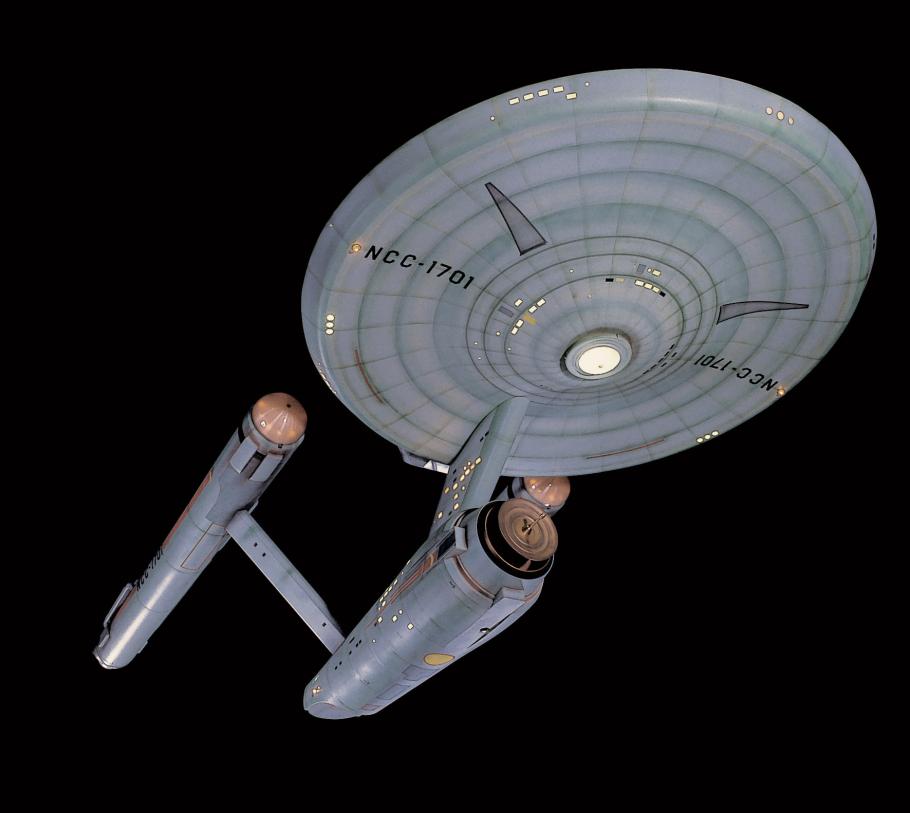When the Boeing Milestones of Flight Hall opens in the summer of 2016, one of its central artifacts will be the Star Trek starship Enterprise studio model, used to film the original television series. As a member of the curatorial team that has been working on this exciting revision of the Milestones Hall, I have been immersed in the culture and lore of that artifact, as I have sought to place it in the context of the Lunar Module, Spirit of St Louis, Bell X-1, and other iconic artifacts that will populate the space. What follows are some observations.
This 3.4 meter (11-foot) model of the fictional starship Enterprise was used to film the weekly hour-long Star Trek television show.
On September 12, 1962, at Rice University in Houston, Texas, President John F. Kennedy gave a speech that stated the country’s commitment to landing human beings on the Moon and returning them safely by the end of that decade. In the speech’s most memorable passage, he said:
We choose to go to the moon. We choose to go to the moon in this decade and do the other things, not because they are easy, but because they are hard, because that goal will serve to organize and measure the best of our energies and skills, because that challenge is one that we are willing to accept, one we are unwilling to postpone, and one which we intend to win...
That statement echoed one that was given over six decades earlier in 1900. At the second International Congress of Mathematicians in Paris, Professor David Hilbert listed a set of mathematical problems that he suggested his colleagues ought to be able to work on for the coming century. Like President Kennedy, Hilbert was remarkably prescient. His list of 23 problems served to define mathematics for the following century and beyond. In choosing such problems, Hilbert acknowledged that he could not foresee the future with any clarity, but he was guided by this criterion:
…a mathematical problem should be difficult in order to entice us, yet not completely inaccessible, lest it mock our efforts.
- Advances in launch vehicle technology, led by companies such as SpaceX
- The development of ion propulsion, predicted decades ago but only now becoming a practical reality for spacecraft
- Deep space guidance and navigation, as demonstrated by the pinpoint landing of Curiosity on Mars in the fall of 2012
- The almost daily discovery of exoplanets in our galaxy, including some that are in the habitable “Goldilocks” zone
- Advances in robotics, from companies such as Boston Dynamics
- the development of computer-based imaging, giving us new tools to analyze telescope data and spectacular images from the Hubble Space Telescope
- Advances in artificial intelligence (AI), a dream of computer scientists where progress had been agonizingly slow, but is now accelerating at a fast pace
- The further understanding of the elementary particles that make up our universe, as a result of the operation of the Large Hadron Collider
- The increased accessibility of general and scientific knowledge that has been enabled by the Internet
Some of these were hinted at in Star Trek episodes, but for me, the sum of these goes far beyond the world envisioned by Gene Roddenberry 50 years ago. We will restore the Enterprise, and it will be a fantastic addition to the Milestones Hall. But as I have said elsewhere, space exploration does not always follow the trajectories we want it to. As for visiting other intelligent civilizations in our galaxy? An attempt to develop warp drive would “mock our efforts,” as Hilbert warned. I suggest an avenue of research that is “difficult enough to entice us, yet not completely inaccessible.” That would be the development of AI to a point where we can download our consciousness onto swarms of robotic spacecraft and send them out into the galaxy. I predict that a first step along these lines will become a reality within my lifetime.
Among the problems that David Hilbert proposed in 1900 was #10: whether it could be “decided” that a certain mathematical function was solvable or not. A variant of that problem was eventually solved, in the negative, by the Cambridge mathematician Alan Turing. Hilbert had hoped for a positive answer to the “Decision Problem,” but Turing’s 1936 paper laid the theoretical foundations for the digital computer—a device that is only present in a rudimentary form in Star Trek, by the way. Hilbert was on to something after all.
To the skeptics who wonder why the Utopia of space travel implied by the Apollo landings of 1969-1972 has not come to pass, I would only say that we are living in an age of discovery that has no parallel in human history. Let’s embrace it.
